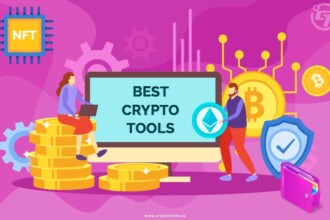Imagine a world where blockchain isn’t just a tech buzzword but the superhero of the digital realm. Now, enter the Avalanche Network, a place where speed, scalability, and innovation aren’t just promised – they’re delivered faster than your favorite pizza. This isn’t just any old blockchain; think of it as a rocket ship in a world of hot air balloons, zooming past the competition with a trail of icy coolness.
It’s like the cool new kid on the block who not only plays electric guitar but also solves Rubik’s cubes in record time. Dubbed the “Ethereum Killer,” Avalanche is turning heads and making waves in the crypto ocean with its slick features and frosty finesse.
So, what makes Avalanche the blockchain equivalent of a double black diamond ski run? Let’s glide through its snowy peaks and explore its breathtaking landscapes, from its unique consensus mechanisms that are as groundbreaking as the first snowboard, to its customizable blockchains that are as diverse as snowflakes.
Let’s go.
What is Avalanche Network?
Avalanche Network is a decentralized, open-source blockchain platform known for its high throughput, low latency, and scalability.
Launched in September 2020 by a team of savvy tech wizards at Ava Labs, led by the legendary Cornell professor Emin Gün Sirer, Avalanche has quickly become the talk of the blockchain town.
Avalanche positions itself as a competitor to Ethereum, often dubbed as an “Ethereum Killer,” due to its advanced capabilities in terms of transaction speed, scalability, and cost-efficiency.
You might think, what is so special about it? Here are some key features that you might take a look at.
- Consensus Mechanisms: Avalanche uses a unique consensus protocol that is a blend of classical consensus and Nakamoto consensus, providing a high degree of decentralization and security while enabling the network to process thousands of transactions per second (TPS).
- Speed and Scalability: One of the most notable aspects of Avalanche is its speed. The network claims to finalize transactions in under a second, which is significantly faster compared to Ethereum’s current capabilities.
- Customizable Blockchains: The platform allows for the creation of both private and public blockchains. Users can launch their own tailor-made blockchains, called “subnets,” with specific functionalities suited to their needs.
- Interoperability: Avalanche supports the creation of multiple custom blockchains that can interact and transact with each other within the Avalanche ecosystem, promoting interoperability.
- Smart Contracts: Like Ethereum, Avalanche supports decentralized applications (dApps) and smart contracts, enabling developers to build a wide range of applications on its platform.
- Energy Efficiency: The consensus mechanism of Avalanche is also designed to be energy-efficient compared to the traditional Proof of Work (PoW) systems.
- Governance: AVAX, Avalanche’s native token, not only serves as a means of payment and a store of value but also plays a role in the governance of the network, giving holders a say in the future development of the platform.
- EVM Compatibility: Avalanche is compatible with Ethereum Virtual Machine (EVM), which allows Ethereum developers to easily port their applications over to Avalanche.
How Avalanche Network Works
As discussed earlier, Avalanche Network distinguishes itself through a novel approach to blockchain technology, characterized by its unique consensus mechanism and extraordinary architecture.
At its core, Avalanche deploys a consensus protocol that merges principles from both Classical and Nakamoto consensus models. This hybrid consensus is not only energy-efficient but also achieves rapid finality of transactions, often within a few seconds. Such speed and efficiency make it a standout in the blockchain space, particularly when compared to slower networks.
The network is comprised of three integral blockchains, each serving a distinct purpose.
- The Exchange Chain (X-Chain) is responsible for managing Avalanche’s native token, AVAX, and other digital assets. It is particularly notable for its high-speed transactions enabled by the Avalanche consensus.
- The Contract Chain (C-Chain), compatible with the Ethereum Virtual Machine (EVM), facilitates the deployment of smart contracts and decentralized applications (dApps), offering a familiar environment for Ethereum developers and the added advantages of Avalanche’s speedy transaction processing and lower fees.
- Lastly, the Platform Chain (P-Chain) is the backbone of the network’s coordination and governance, overseeing validators and allowing the creation of new subnets.
Subnets, Smart Contracts & AVAX Tokens
Subnets are a pivotal feature of Avalanche, providing the ability for users to create custom blockchains with specific properties and use cases. This flexibility paves the way for a range of applications, from private enterprise solutions to specialized public networks, all while maintaining interoperability within the Avalanche ecosystem.
In terms of smart contract execution, the C-Chain’s EVM compatibility invites a diverse array of dApps, including those in the realms of decentralized finance (DeFi) and non-fungible tokens (NFTs). This compatibility not only fosters a rich and varied dApp ecosystem but also positions Avalanche as an attractive alternative for developers and users facing high fees and slower transaction times on other platforms.
The AVAX token is central to the Avalanche network, serving various roles including transaction fees, staking, and governance. Staking AVAX tokens allows users to become validators, contributing to network security and earning rewards in the process. Moreover, AVAX holders have a say in the network’s governance, influencing key decisions and future developments.
Avalanche’s design emphasizes not only scalability and efficiency but also environmental consciousness, setting it apart from traditional Proof of Work (PoW) systems by requiring significantly less energy for its operations. This blend of rapid processing reduced energy consumption, and EVM compatibility.
Avalanche vs Ethereum Network: Which One Is Better?
Comparing Avalanche Network with Ethereum highlights some key differences, particularly in their consensus mechanisms, transaction speed, scalability, and overall architecture.
Below are some of the notable distinctions, including statistics like transactions per second (TPS):
Consensus Mechanism:
- Ethereum: Originally employed a Proof of Work (PoW) mechanism but has transitioned to Proof of Stake (PoS) with its Ethereum 2.0 update. PoS aims to increase transaction speed and reduce energy consumption.
- Avalanche: Uses a unique consensus protocol that combines elements of Classical and Nakamoto consensus mechanisms. This approach is known for its energy efficiency and rapid transaction finality.
Transactions Per Second (TPS):
- Ethereum: Prior to Ethereum 2.0, the network could handle about 30 TPS. With the upgrade to Ethereum 2.0, the TPS is expected to increase significantly, potentially exceeding 100,000 TPS due to sharding and other improvements.
- Avalanche: Can process around 4,500 TPS on its C-Chain, which is significantly higher than Ethereum’s pre-2.0 capability. This high throughput is one of Avalanche’s key selling points.
Block Time and Finality:
- Ethereum: Initially had a block time of approximately 13-15 seconds. With Ethereum 2.0, this time is expected to decrease, improving transaction speeds and finality.
- Avalanche: Offers sub-second block times on the X-Chain and a finality time of around 2 seconds, which is notably faster than Ethereum’s pre-2.0 timings.
Scalability:
- Ethereum: The shift to Ethereum 2.0 introduces sharding, which is expected to greatly enhance scalability and reduce network congestion.
- Avalanche: Inherently scalable due to its unique architecture featuring multiple chains (X-Chain, C-Chain, P-Chain) and the ability to create custom subnets. This design allows it to handle a large number of transactions efficiently.
Smart Contract Capabilities:
- Ethereum: Known for its robust smart contract ecosystem, hosting a vast array of decentralized applications (dApps). Its transition to Ethereum 2.0 aims to retain these capabilities while improving efficiency.
- Avalanche: Compatible with Ethereum’s smart contracts via its C-Chain, enabling developers to port Ethereum dApps to Avalanche easily. This has encouraged the growth of a diverse dApp ecosystem.
Network Fees:
- Ethereum: Has struggled with high gas fees, particularly during times of network congestion. Ethereum 2.0 aims to address this issue.
- Avalanche: Generally offers lower transaction fees compared to Ethereum, making it an attractive alternative for users and developers.
Energy Consumption:
- Ethereum: PoW was energy-intensive, but the move to PoS with Ethereum 2.0 significantly reduces its carbon footprint.
- Avalanche: Designed with energy efficiency in mind, its consensus mechanism requires far less power than traditional PoW systems.
Developer and User Base:
- Ethereum: Boasts a large and established community of developers and users, being the first-mover in the smart contract space.
- Avalanche: While growing rapidly, its community and ecosystem are still smaller compared to Ethereum’s.
In nutshell, Avalanche Network, with its high TPS, low fees, and rapid finality, presents itself as a formidable competitor to Ethereum, especially for users and developers looking for faster and more cost-effective solutions.
Here note that, Ethereum’s transition to Ethereum 2.0 and its established ecosystem continue to make it a dominant force in the blockchain world. Also, one can not ignore the growing number of developments on the Ethereum network.
Read Also: Bitcoin or Ethereum: Which One Is Better?
AVAX’s Price Prediction for 2023 & 2024
For 2023, the AVAX token is expected to see a wide price range, potentially fluctuating between $16 and $361. Short-term forecasts suggest a modest increase to about $10.75 by late October 2023, with an overall average price for the year hovering around $14.49.
Looking ahead to 2024, predictions indicate a possible lower bound of $9.93 and an upper limit of $82.44, portraying a significant range in its market valuation. The average price throughout 2024 is estimated to settle at around $23.25, with lows and highs for the year projected at $16 and $30.5, respectively.
Also, for a better trading experience and to mitigate losses, one can take the support of platforms like https://immediateedge-fr.com/. Through their expertise and guidance, crypto enthusiasts can enjoy their crypto investment.
Disclaimer: These predictions reflect the inherent volatility and dynamic nature of the cryptocurrency market, suggesting both cautious optimism and the need for prudent investment strategies.
Conclusion:
Avalanche presents itself as a strong contender in the blockchain space, addressing some of the key issues faced by Ethereum, particularly around scalability and transaction speed. However, whether it can sustainably position itself as an “Ethereum Killer” remains to be seen, considering the ongoing developments and upcoming upgrades in the Ethereum network, like Ethereum 2.0.







